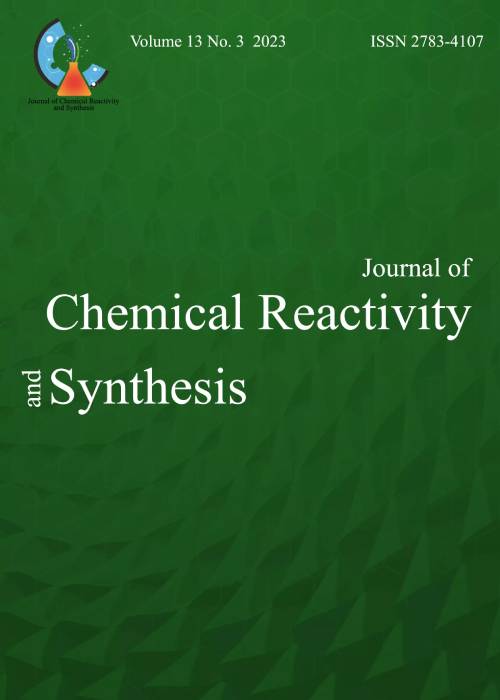فهرست مطالب

Journal of Chemical Reactivity and Synthesis
Volume:11 Issue: 4, Autumn 2021
- تاریخ انتشار: 1400/09/10
- تعداد عناوین: 6
-
Pages 202-216In this study, the perovskite-type LaFeO3 nanoparticles have been fabricated by sol–gel method and characterized by X-ray powder diffraction (XRD), Fourier infrared spectroscopy (FT-IR), scanning electron microscopy (STM) and transmission electron microscopy (TEM). The average particle size of LaFeO3 is about 50 nm and the synthesis of tetrahydropyridine derivatives was investigated by the reaction of aryl aldehydes, aryl amines and ethyl acetoacetate in the presence of heterogeneous catalyst. The high efficiency, short time, the very simple separation of the catalyst from the reaction environment is the advantages of the above method. In addition, the catalyst can be reused and can be used for catalytic activity five times without significant reduction.Keywords: tetrahydropyridine, LaFeO3 nano perovskite, ethanol, Heterogeneous catalyst
-
Pages 217-227Levetiracetam (LV, [S]-alpha-ethyl-2-oxo-1-pyrrolidine acetamide) is a new antiepileptic that has been used as adjunctive therapy to treat patients with intractable epilepsy. Its interaction with bovine serum albumin (BSA) is of great use for the understanding of the pharmacokinetic and pharmacodynamic mechanisms of the drug. The effect of levetiracetam drug on native BSA structure has been studied by UV-visible and circular dichroism methods. In addition, fluorescence spectroscopy was used to investigate the effect of LV on F and B conformers of BSA. UV-visible results indicated that the interaction of LV with BSA may cause the conformational changes in BSA and change the polarity of the microenvironment around tyrosine and tryptophan residues of BSA. Analysis of CD spectrum displayed an increase in content of α-helical structure of BSA induced by LV and stabilized it. This study makes an important contribution to enhance our basic knowledge of the molecular basis of drug-protein interaction, which could be applicable for the development of more efficacious antiepileptic medicines.Keywords: Levetiracetam, BSA, Drug-protein interaction, Spectroscopic methods, structural changes
-
Pages 228-243In this study, the adsorption hydroquinone on polypyrrole (ppy) adsorbents has been investigated using the density functional theory (DFT) method. Calculations were performed at two levels, b3lyp/6-31+G(d,p) and WB97XD/6-31+G(d,p). Studies were in the gas phase and water solvent with the conductive polarizable continuum model (CPCM) model. Evaluation of energy level changes of Homo and Lumo orbitals, hardness, softness, electrophilicity, dipole moment, charge transfer by Mulliken method and natural bonding orbitals, adsorption energy, density of states diagrams, molecular electrostatic potential, intermolecular distances and non-covalent interaction analysis has been performed.Keywords: Adsorption, hydroquinone, Polypyrrole, Density functional theory (DFT)
-
Pages 244-253An efficient synthesis of spiroindolopyranoquinazolines has been achieved in good yields by using one-pot, three-component condensation of alkyl malonates, tryptanthrin, and active methylene compounds in the presence of DABCO as organocatalyst in CH3CN at refluxKeywords: Tryptanthrin, One-pot, Spiropyran, Alkyl malonates, Spiroindoloquinazoline
-
Pages 254-263Immobilization of molybdenum (VI) ions onto magnetic nanoparticles have been successfully prepared and applied for C–X cross-coupling reactions with aryl halides in green deep eutectic solvents. The results prove that the Fe3O4@SiO2−HNPABA−Mo(VI) magnetic nanoparticles show high catalyst activity and good stability. It was also revealed that this complex can be recycled up to five times without any significant loss in catalytic activityKeywords: cross-coupling, magnetic, Nanocatalyst, Immobilization
-
Pages 264-270Ultrasonic irradiation was effectively used for the synthesis of one pot chalcon-quinoxaline derivatives with high efficiency and short time. The products are obtained by mixing parahydroxy acetophenone and various aldehydes or parahydroxy benzaldehyde with different ketones and then adding 2,6-dichloroquinoxaline, in the presence of catalytic amounts of pyrrolidine as a organocatalyst and DMF as a solvent. These conjugated chalcon-quinoxaline derivatives have been shown to have good anticancer activity.Keywords: Ultrasonic mediation, Organocatalysts, Chalcone, Quinoxaline, Chalcon-quinoxaline


